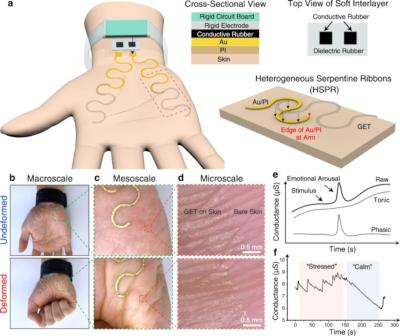The Graphene-Info weekly newsletter
Published: Tue, 12/06/22
The Graphene-Info newsletter (December 7, 2022)
Cannot read this? View it online here
Graphene oxide could help harvest ocean osmotic energy
Researchers from Deakin University's Institute for Frontier Materials (IFM) aim to harness the ocean's potential for renewable and clean energy. In a recent study, they demonstrated how a two-dimensional (2D) nanomaterial membrane technology can improve blue energy harvesting processes. Blue energy harvesting is renewable energy that uses the salt content difference between river water and seawater to generate electricity.
"Ocean energy is made up of five forms—tidal, water waves, ocean currents, temperature gradients and salinity gradient energy, offering a potential alternative, limitless energy resource," says Associate Professor Weiwei Lei, who is leading the sustainable energy generation project at IFM. "Therefore, harvesting ocean energy through artificial devices has attracted tremendous interest. In particular, salinity gradient energy, also called 'osmotic energy' or 'blue energy,' provides significant promise for the development of renewable energy. It has a potential 1 TW energy (8500 TW h in a year), which exceeds the sum of hydraulic, nuclear, wind and solar energy in 2015. With the development of nanotechnology and 2D nanomaterials, novel 2D nanomaterials' membranes with nanopores and nanochannels were designed for blue energy harvesting. However, the energy harvesting efficiency of these membranes is still too low to meet the demands of practical applications due to their high internal resistance and low selectivity of ions. New advanced 2D nanomaterial membranes with novel and robust properties will solve this problem, which is in high demand now."
Directa Plus announces grant to develop graphene paints and coverings
Directa Plus has been awarded a €136,000 grant from the Italian region of Lombardy to develop paints and coverings with its G+ graphene nano-platelets. “This grant from the Lombardy local government will help fund Directa Plus to develop these potentially disruptive products in a faster timeframe than we could have achieved using our own resources,” said founder and chief executive Giulio Cesareo in a statement.
Directa has created a new technology, called Grafyshield, a granular, semi-finished G+ formulation for the coatings market. Grafyshield is “designed to be easy to handle and mixable with resins using mixing equipment,” the producer and supplier of nano-platelets-based products said. The target for the new formulation is to bring anti-corrosion and flame-retardant properties to the final paint system.
Various graphene technologies to be tested during moon and space missions
Graphene Flagship Partners University of Cambridge (UK) and Université Libre de Bruxelles (ULB, Belgium) collaborated with the Mohammed bin Rashid Space Centre (MBRSC, United Arab Emirates) and the European Space Agency (ESA) to test graphene on the Moon. This joint effort sees the involvement of many international partners, such as Airbus Defense and Space, Khalifa University, Massachusetts Institute of Technology, Technische Universität Dortmund, University of Oslo, and Tohoku University.
The MASER15 launch. Credit: John-Charles Dupin/Eurekalert
The Rashid rover is planned to be launched today (30 November 2022) from Cape Canaveral in Florida and will land on a geologically rich and, as yet, only remotely explored area on the Moon’s nearside – the side that always faces the Earth. During one lunar day, equivalent to approximately 14 days on Earth, Rashid will move on the lunar surface investigating interesting geological features.
Graphenea reports excellent market reaction to its mGFET devices
In June 2022, Graphenea launched its latest product out of its Graphene Foundry, the mGFET, fully-packaged mini graphene-based field effect transistors.
Graphenea now updates that the market demand for these products has been excellent, and it has run out of stock. The company is now working to produce more mGFET devices and restock.
The mGFETs are Graphenea's highest value-chain products, which are manufactured and packaged in chip carriers, and can be used together with the Graphenea Card for seamless sensor development (which was released earlier in 2022, and has also seen very good reception in the industry).
Sparc Technologies starts construction of new manufacturing facility
Sparc Technologies (SPN) has announced kicking off the construction of a modular and scalable manufacturing facility for graphene-based additive products in Adelaide. The company said that commissioning was expected within the first quarter of 2023.
This facility will enable the production of commercial quantities of graphene-based additives and will accommodate large-scale manufacturing to meet customer demand.
Graphene e-tattoo can measure stress levels
Researchers at The University of Texas at Austin and Texas A&M University have used electronic tattoo (e-tattoo) technology to measure stress levels, by attaching a device to people's palms (AKA electrodermal activity or EDA sensing). The researchers created a graphene-based e-tattoo that attaches to the palm, is nearly invisible and connects to a smart watch.
In June 2022, researchers from the same universities also developed a graphene-based electronic tattoo that can be worn on the wrist for hours and deliver continuous blood pressure measurements at an accuracy level exceeding nearly all available options on the market today.
Directa Plus reports on financial status, expects annual revenue to rise
Directa Plus recently said it expects its revenue to rise in 2022 due to a growing proportion of repeat customer business. Directa Plus expects full-year revenue for 2022 to now be at least €10.0 million, up 16% from €8.6 million in 2021.
Directa Plus said it will enter 2023 with a ‘record’ order book of €8.5 million, having secured a number of new customers and contracts during the period across all key verticals and markets.
Researchers use natural surfactant for efficient liquid-phase exfoliation of graphene
Researchers from India's SRM Institute of Science and Technology have reported on a natural, environmentally friendly and sustainable surfactant for exfoliating graphene in water.
Aqueous graphene dispersions hold potential for many applications such as printed and paper electronics and polymer composites, but the water’s surface energy tends to be too high to stabilize them. However, surfactants provide adequate repulsive potential against restacking of exfoliated nanosheets in colloidal dispersions to overcome the van der Waal’s attractive forces. The major problem with reported and commercial surfactant resources is their inability to produce micrometer-sized graphene with few defects at high yield with using a minimal amount of economical and sustainable surfactants.
Versarien provides G-SCALE updates
On 1 July 2020, Versarien announced that the UK Government, via Innovate UK, had granted a £5 million loan to the Company, for a project named G-SCALE, an acronym for Graphene, Seat, Concrete, Arch, Leisure, Elastomer. The award was to facilitate the production of sufficient quantities of graphene to enable commercialization of graphene-enhanced products in these five priority application areas.
Recently, Versarien has provided a summary of G-SCALE progress for each of the relevant segments.
Metalgrass LTD
9 Har Tsin St.
Kfar Sava Hasharon 4430809
ISRAEL
Unsubscribe | Change Subscriber Options






